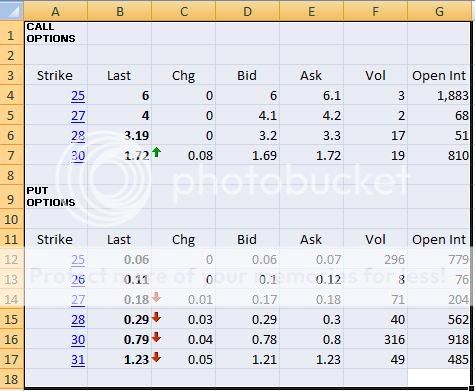I have read that the bid ask spread is dependent on the liquidity and the transactions costs, but have no idea how the liquidity/transaction costs actually translate into numbers.
Let us say that the current stock price of "GreekGod corporation" is $31.00.
For the month of february, the Call and Put option bid-ask spreads and strike prices are as given below.

Now say if the liquidity has increased then what would be the option prices? If say the liquidity decreased then what would be the option price be? (both bid and ask).
What is the effect of Implied volatility on the option price or is it the other way around? One of the traders I talked to told me that option price is used to arive at the volatility (this statement was a bouncer for me). I mean what would the market maker do knowing the volatility?
Deltas: How would one hedge the above options using deltas?
Let us say that the current stock price of "GreekGod corporation" is $31.00.
For the month of february, the Call and Put option bid-ask spreads and strike prices are as given below.

Now say if the liquidity has increased then what would be the option prices? If say the liquidity decreased then what would be the option price be? (both bid and ask).
What is the effect of Implied volatility on the option price or is it the other way around? One of the traders I talked to told me that option price is used to arive at the volatility (this statement was a bouncer for me). I mean what would the market maker do knowing the volatility?
Deltas: How would one hedge the above options using deltas?
